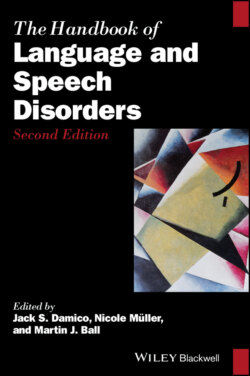Читать книгу The Handbook of Language and Speech Disorders - Группа авторов - Страница 23
1.5 Concerns with the Process of Diagnostic Labeling
ОглавлениеGiven the fact that labeling has a long history of application in education, medicine, and the social and psychological sciences, that it arises out of the human propensity to generalize, stereotype and construct meaning, and that there appear to be both positive and negative consequences of labeling, the process is well ingrained in our sociocultural context. Progressively, however, as social science addresses complexity and has established developmental and epistemological orientations that are less positivistic in nature and focused more on social constructivism (Bruner, 1986, 1990, 1991; Danziger, 1990; Gergen & Davis, 1985; Goodman, 1978; Iran‐Nejad, 1995; O’Connor, 1998; Shuell, 1986), there have been growing concerns about the process of labeling. Labeling is seen as too subjective and vague, especially given its power in the spheres of social action. Foremost in the litany of concern is the linkage of labeling with assessment.
As a widespread practice, assessment is a fairly recent phenomenon (Broadfoot, 1994; Gipps, 1999). In the context of the attempt to develop a more scientific foundation for the discipline of psychology at the beginning of the twentieth century, assessment was seen as a way to demonstrate both scientific principles and practical utility (Gould, 1996; Mills, 1998). When psychometric theory was developed in tandem with the creation of intelligence testing (Bernstein, 1996; Goldstein, 1996; Lohman, 1997), there was an allure of the objective and scientific. This was a time of behaviorism and a belief in positivism and it was taken for granted that the assessment of human abilities, skills, and proficiencies could be effectively accomplished through the development of test instruments. The use of quantification and statistical formulae helped advance this perception. However, to construct testing with sufficient statistical power, especially regarding reliability indices, a strict standardization was required that impacted test design, item selection, administrative procedures, and scoring criteria of the tests; these efforts to boost technical reliability often had a negative effect on the construct validity and the practical and clinical impact of the tests (Cronbach, 1988; Damico, 1991; Goldstein, 1996; Lohman, 1997; Messick, 1984). This resulted in ineffective assessment tools that were typically perceived to be valid and effective.
In remedial public education in the United States, the major regulatory instrument is the Individuals with Disabilities Education Act (IDEA). Because of continued disenchantment with the traditional approach to special education, the recent IDEA re‐authorization discussed several obstacles to implementing effective special education services (Hamayan et al., 2013; Sternberg & Grigorenko, 2002). Among the obstacles cited were that implementation of the Act has been impeded by a disproportionately high number of referrals and placements of “minority children” in special education, and by the application of discrepancy models using inappropriate tests that often result in these disproportionate placements. Consequently, regulations have been modified to address the needs of the students and to determine eligibility for special education services; pre‐referral interventions (a kind of dynamic assessment) rather than tests and other assessments have been recommended, and the focus directly shifts from evaluation with testing instruments to intervention potential as the primary determinant of placement. Additionally, the new documents do not require test scores to make placement decisions into special education.
